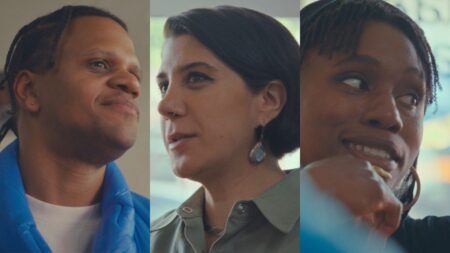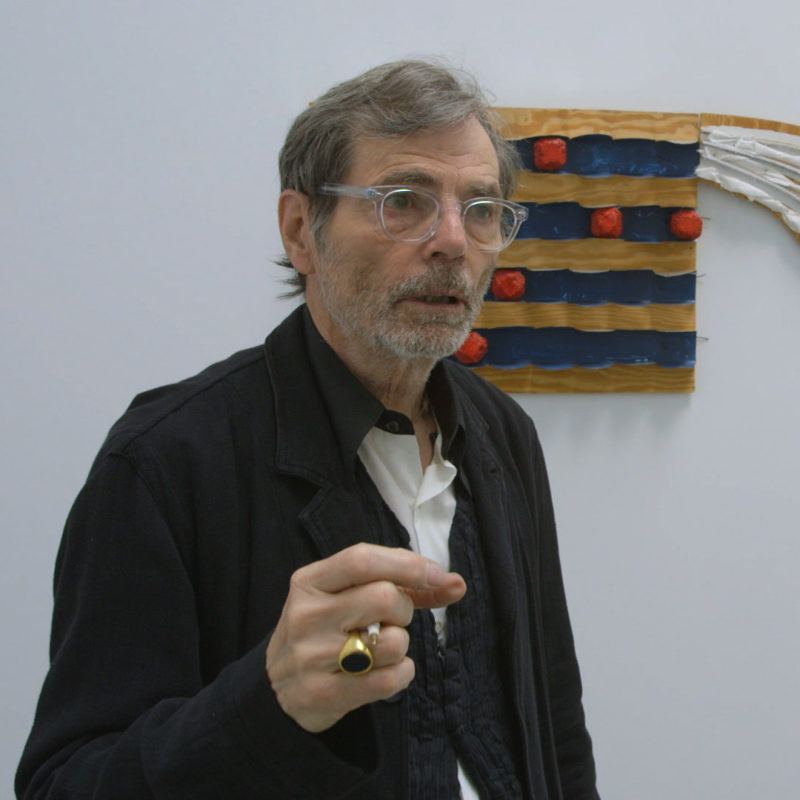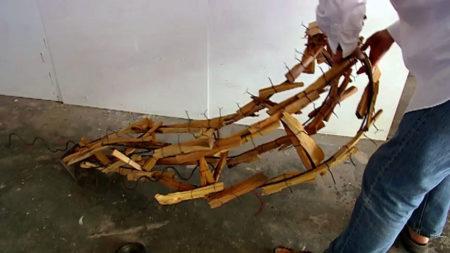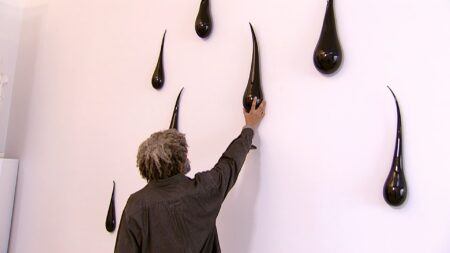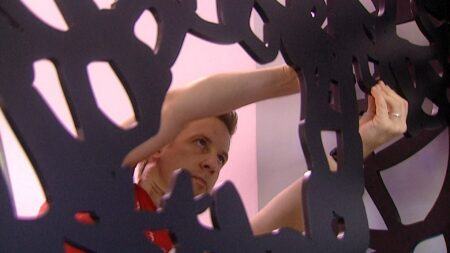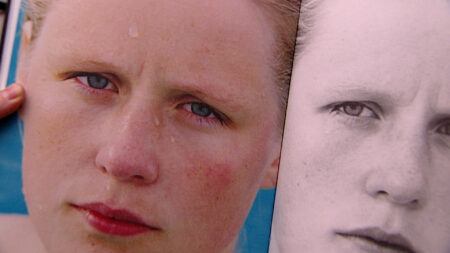Continue playing
(Time remaining: )
Play from beginning
Continue playing "{{ controller.videos[controller.getVideo(controller.currentVideo)].segmentParentTitle}}"
{{controller.videos[controller.getVideo(controller.currentVideo)].title}} has ended.
Richard Tuttle in "Structures"
“A painting or a sculpture really exists somewhere between what it is and what it is not,” says Richard Tuttle. Tuttle uses humble materials such as paper, wire, and string to create art “that accounts for the invisible.” Tuttle sees his current work as “a conjoining of architecture and calligraphy.”
In an exhibition at The Drawing Center in New York, Tuttle creates “villages” in which sculptures invite viewers into a contemplative relationship with the artist’s diminutive drawings. “The emotion of an art response does to me feel like motion,” he observes. “We use that word moved. ‘I am moved.’ And yet we know we’re standing right there and we have this experience of being stationary and moved at the same time.”
Credits
Created by: Susan Sollins & Susan Dowling. Executive Producer & Curator: Susan Sollins. Series Producer: Eve-Laure Moros Ortega. Associate Producer: Migs Wright. Assistant Curator: Wesley Miller. Production Manager: Alice Bertoni. Production Coordinator: Kelly Shindler. Producer: Catherine Tatge. Editor: Steven Wechsler. Host: Sam Waterston. Director of Photography: Kurt Branstetter, Terry Doe, Bob Elfstrom, Clas Hakeröd, Mead Hunt, Matz Jansson, Rodrigo Menck, James Reid, & Joel Shapiro. Sound: Abrão Cesar, Danny Clayton, Ray Day, Ron Garson, Judy Karp, Matti Karlsson, Mark Mandler, J.T. Takagi, & Merce Williams. Steadicam: John Ford. Gaffer: Lamar Bloodworth. Assistant Camera: Craig Feldman, Brian Hwang, Kipjaz Savoie, & Trent Wittenbach. Production Assistant: Rob Cauble, Erica Gannett, Justin Leitstein, & Mary Jo Mauro. Assistant Avid Editor: Robert Achs, Jamie Courville, Sean Frechette, Mike Heffron, David Kreger, Cara Leroy O’Connell, Joaquin Perez, Aaron Sheddrick, & Lynn True. Still Photographers: Alice Bertoni & Bob Elfstrom.
Creative Consultant: Ed Sherin. Art Design & Animation: Open, New York. On-Line Editor: Don Wyllie & Frame:Runner NYC. Composer: Peter Foley. Voice-Over Artist: Jace Alexander. Sound Editing: Margaret Crimmins, Greg Smith, & Dog Bark Sound. Sound Mix: Tony Volante & Sound Lounge. Animation Stand: Frank Ferrigno & Frame:Runner NYC. Introductory Host Segments Created by: INTERspectacular. Commissioned Video Art by: Teresa Hubbard / Alexander Birchler.
Artworks Courtesy of: Roni Horn; Matthew Ritchie; Richard Tuttle; Fred Wilson; The Drawing Center, New York; Crown Point Press, San Francisco; Matthew Marks Gallery, New York; Metro Pictures, New York; Andrea Rosen Gallery, New York; PaceWildenstein, New York; & Sperone Westwater Gallery, New York.
Special Thanks: Mariana Valdrighi Amaral; The Art21 Board of Trustees; The Art Institute of Chicago; Margrét Blöndal; Charlotte Burns; Jordan Bastien; Jim Caffrey; Contemporary Arts Museum, Houston; Curious Pictures; Victoria Cuthbert; Ali Evans; Andrea Hall; R.S. Hahn; Hauser & Wirth Gallery, London; Garland Hunter; Petra Johansson; Jennifer Joy; Jeannie and Michael Klein; Sarah Kurz; John Landewe; MASS MoCA; The Museum of World Culture, Sweden; Neta Normo; Karen Polack; Rutgers Center for Innovative Print and Paper; Larry Smallwood; XXVI São Paulo Bienal; Soundtrack F/T; The Studio Museum in Harlem; Tai Gallery, Santa Fe; Ttweak; University of Akureyri, Iceland; & Georgia Loy Weinberg.
Director of Education & Outreach: Jessica Hamlin. Director of Development: Kathi Pavlick. Development Associate: Sara Simonson.
Interns: Susan Agliata, Nathan Townes-Anderson, Hannah Blumenthal, Agnes Bolt, Lisa Charde, Mary Chou, Kate Crawford, Amanda Donnan, Sophie Dunoyer de Segonzac, Suzy Foster, Jules Gaffney, Katie Hen, Heather Hughes, Adam Krakowski, Georgia Kung, David Mark Kupperberg, Maiko Kyogoku, Phil Logan, Lisa Margulies, Michelle Maydanchik, Carla Meyers, Christine Miller, Geoffrey Pan, Sujay Pandit, Jihan Robinson, Jennifer Sarkilahti, Megan Scally, Karen Seapker, Greg Shilling, Sarah Sliwa, Jennifer Smith, & Elizabeth Swift.
Public Relations: Kelly & Salerno Communications. Station Relations: De Shields Associates, Inc. Legal Counsel: Albert Gottesman. Bookkeeper: Marea Alverio-Chaveco & William Handy.
Major underwriting for Season 3 of Art in the Twenty-First Century is provided by National Endowment for the Arts, PBS, Agnes Gund and Daniel Shapiro, Nathan Cummings Foundation, Corporation for Public Broadcasting, Jon and Mary Shirley Foundation, Bagley Wright Fund Bloomberg, The Horace W. Goldsmith Foundation, JPMorgan Chase, Melva Bucksbaum and Raymond Learsy, The Paul G. Allen Family Foundation, and The Andy Warhol Foundation for the Visual Arts.
Closed captionsAvailable in English, German, Romanian, Italian, Japanese, Korean, Chinese, Italian
Through the Art21 Translation Project, multilingual audiences from around the globe can contribute translations, making Art21 films more accessible worldwide. Translate this video now.
Interested in showing this film in an exhibition or public screening? To license this video please visit Licensing & Reproduction.
Even when considering his three-dimensional works, Richard Tuttle commonly refers to his art as drawing rather than sculpture—the distinction emphasizing the diminutive scale and idea-based nature of his work. Influenced by calligraphy, architecture, and poetry, he subverts the conventions of modernist sculptural practice by creating small, eccentrically playful objects in humble, fragile materials. Tuttle also manipulates the space in which his objects exist, placing them unnaturally high or oddly low on a wall—forcing viewers to reconsider and renegotiate the white-cube gallery space in relation to their own bodies.
“A painting or a sculpture really exists somewhere between what it is and what it is not.”
Richard Tuttle
